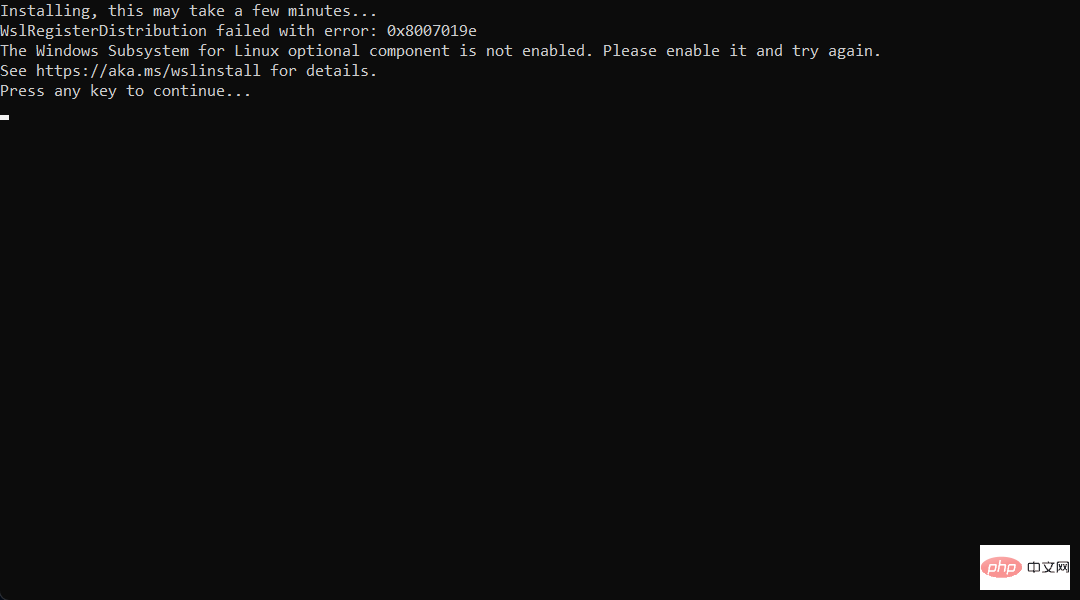 Operation and Maintenance
Operation and Maintenance Linux Operation and Maintenance
Linux Operation and Maintenance Linux server security: Ensure the integrity of web interface data.
Linux server security: Ensure the integrity of web interface data.
Linux server security: ensuring the integrity of Web interface data
With the popularity and development of the Internet, Web interfaces have become an important part of modern applications . However, the accompanying data security issues have become increasingly prominent. In order to protect the integrity of user data, we need to take a series of security measures. This article will focus on methods to ensure the integrity of Web interface data on Linux servers, and attach corresponding code examples.
1. Overview
Ensuring the integrity of Web interface data means ensuring that the data is not tampered with or damaged during the data transmission process. Data integrity can be ensured by using encryption algorithms for data encryption and digital signatures for data verification.
2. SSL/TLS encrypted communication
SSL/TLS is a network security protocol used to establish encrypted communication between the client and the server. Using SSL/TLS ensures that data is not stolen or tampered with during transmission. Here is a simple example using the Python Flask framework and SSL/TLS:
from flask import Flask
from OpenSSL import SSL
context = SSL.Context(SSL.PROTOCOL_TLSv1_2)
context.load_cert_chain(certfile='cert.pem', keyfile='key.pem')
app = Flask(__name__)
@app.route('/')
def hello():
return "Hello, World!"
if __name__ == '__main__':
app.run(ssl_context=context)In the above example, we use the OpenSSL library to generate the SSL/TLS certificate and load the certificate in the Flask application. In this way, the communication between the client and the server is encrypted via SSL/TLS, ensuring data confidentiality and integrity.
3. Digital signature to verify data integrity
Using digital signatures can verify the integrity of the data and ensure that the data has not been tampered with during transmission. The following is an example of using Python's hashlib and hmac libraries to generate and verify digital signatures:
import hashlib
import hmac
# 生成签名
def generate_signature(data, secret_key):
hmac_obj = hmac.new(secret_key.encode(), msg=data.encode(), digestmod=hashlib.sha256)
return hmac_obj.hexdigest()
# 验证签名
def verify_signature(data, signature, secret_key):
expected_signature = generate_signature(data, secret_key)
return signature == expected_signature
data = "Hello, World!"
secret_key = "secret_key"
# 生成签名
signature = generate_signature(data, secret_key)
print("Signature:", signature)
# 验证签名
is_valid = verify_signature(data, signature, secret_key)
print("Is Valid:", is_valid)In the above example, we use the hmac library to generate a digital signature based on the SHA-256 hash algorithm. By verifying signatures, we can ensure data integrity and prevent data from being tampered with during transmission.
4. Use a firewall to restrict access
On a Linux server, use a firewall to restrict access to the Web interface to prevent unauthorized access and attacks. The following is an example of configuring firewall rules using iptables:
# 允许SSH访问 iptables -A INPUT -p tcp --dport 22 -j ACCEPT # 允许HTTP和HTTPS访问 iptables -A INPUT -p tcp --dport 80 -j ACCEPT iptables -A INPUT -p tcp --dport 443 -j ACCEPT # 其他规则 # ... # 默认拒绝所有其他访问 iptables -A INPUT -j DROP
In the above example, we set some basic firewall rules through iptables, including allowing SSH, HTTP, and HTTPS access, and prohibiting other access. This can effectively restrict illegal access to the Web interface and improve server security.
5. Summary
By using SSL/TLS to encrypt communication, digital signatures to verify data integrity, and using firewalls to restrict access, we can effectively ensure the integrity of Web interface data. In practical applications, we can also combine other security measures, such as access control, logging and vulnerability scanning, to comprehensively improve the security of the server. I hope this article will be helpful to ensure the security of Linux servers.
Reference:
- Flask Documentation. Retrieved from: https://flask.palletsprojects.com/
- Python Documentation. Retrieved from: https:// docs.python.org/
- OpenSSL Documentation. Retrieved from:https://www.openssl.org/
The above is the detailed content of Linux server security: Ensure the integrity of web interface data.. For more information, please follow other related articles on the PHP Chinese website!
 Linux服务器的SSH连接断开问题如何解决?Jun 30, 2023 pm 08:27 PM
Linux服务器的SSH连接断开问题如何解决?Jun 30, 2023 pm 08:27 PM如何解决Linux服务器上的SSH连接中断问题随着云计算和远程工作的普及,远程连接到Linux服务器成为了日常工作中不可或缺的一部分。然而,有时SSH连接可能会出现中断的情况,给我们带来不便和困扰。本文将分享一些解决Linux服务器上SSH连接中断问题的方法,帮助您更好地管理和维护服务器。一、网络问题首先,我们需要排除网络问题。网络稳定与否直接影响到SSH连
 如何解决Linux服务器上的SSH连接中断和拒绝问题Jun 29, 2023 am 09:02 AM
如何解决Linux服务器上的SSH连接中断和拒绝问题Jun 29, 2023 am 09:02 AM如何解决Linux服务器上的SSH连接中断和拒绝问题在日常的运维工作中,使用SSH(SecureShell)进行远程连接是非常常见的操作。尽管SSH是一种安全可靠的协议,但有时仍然会遇到连接中断和拒绝的问题。这些问题可能由于各种原因引起,本文将介绍一些常见的解决方法。检查网络连接首先,确认服务器和本地机器之间的网络连接是否正常。可以通过ping命令来测试服
 想在 Windows 11 上安装 AlmaLinux?这是怎么做的Apr 30, 2023 pm 08:13 PM
想在 Windows 11 上安装 AlmaLinux?这是怎么做的Apr 30, 2023 pm 08:13 PM在MicrosoftStore中,现在有一个版本的AlmaLinux与适用于Linux的Windows子系统兼容。这为用户提供了一系列令人印象深刻的新选项,因此我们将向您展示如何在Windows11上安装AlmaLinux。它于2021年3月发布,提供了第一个稳定的生产版本,此后该非营利基金会增加了许多新成员。最近的AMD是上个月加入的,时间是2022年3月。借助适用于Linux的Windows子系统,在Windows和Linux世界中工作的开
 Linux服务器安全:使用命令检查系统漏洞Sep 08, 2023 pm 03:39 PM
Linux服务器安全:使用命令检查系统漏洞Sep 08, 2023 pm 03:39 PMLinux服务器安全:使用命令检查系统漏洞概述:在当今的数字化环境中,服务器安全性是至关重要的。针对已知漏洞进行及时的检测和修复,能够有效地保护服务器免受潜在的攻击威胁。本文将介绍一些常用的命令,可用于在Linux服务器上检查系统漏洞,并提供相关的代码示例。通过正确使用这些命令,您将能够增强服务器的安全性。检查系统更新:在开始进行漏洞检查之前,确保您的系统已
 提供更强大的Web接口安全性:Linux服务器的关键实践。Sep 08, 2023 pm 12:51 PM
提供更强大的Web接口安全性:Linux服务器的关键实践。Sep 08, 2023 pm 12:51 PM提供更强大的Web接口安全性:Linux服务器的关键实践在当今的数字时代,Web接口安全性变得越来越重要。随着越来越多的应用和服务转移到云端,服务器安全保护也日益成为关键问题。Linux作为最常用的服务器操作系统之一,其安全性的保护至关重要。本文将介绍一些关键实践,帮助您提供更强大的Web接口安全性。更新和维护操作系统和软件及时进行操作系统和软件的更新是服务
 Linux服务器上常见的日志文件损坏问题及其修复方法Jun 29, 2023 pm 06:00 PM
Linux服务器上常见的日志文件损坏问题及其修复方法Jun 29, 2023 pm 06:00 PMLinux服务器上常见的日志文件损坏问题及其修复方法摘要:日志文件是Linux服务器中非常重要的组成部分,它记录了系统运行过程中的各种操作和事件。然而,由于各种原因,日志文件有时会出现损坏问题,导致服务器无法正常分析和调试。本文将探讨一些常见的日志文件损坏问题,并提供相应的解决方法。引言:在Linux服务器运行过程中,日志文件扮演着至关重要的角色。它们记录了
 Linux服务器安全加固:配置和优化您的系统Sep 08, 2023 pm 03:19 PM
Linux服务器安全加固:配置和优化您的系统Sep 08, 2023 pm 03:19 PMLinux服务器安全加固:配置和优化您的系统引言:在当今信息安全威胁日益增加的环境中,保护您的Linux服务器免受恶意攻击和未经授权的访问变得至关重要。为了加固系统安全,您需要采取一系列的安全措施,以保护您的服务器和其中存储的敏感数据。本文将介绍一些关键的配置和优化步骤,以提高您的Linux服务器的安全性。一、更新和管理软件包安装最新的软件包和更新对于保持系
 Linux服务器防御:保护Web接口免受恶意文件上传攻击。Sep 09, 2023 am 09:06 AM
Linux服务器防御:保护Web接口免受恶意文件上传攻击。Sep 09, 2023 am 09:06 AMLinux服务器防御:保护Web接口免受恶意文件上传攻击近年来,随着网络的普及和发展,Web应用程序的使用越来越广泛。然而,与之伴随而来的是各种安全威胁,其中之一就是恶意文件上传攻击。恶意文件上传攻击是指攻击者向服务器上传包含恶意代码的文件,从而获取服务器权限或者传播恶意内容。为了保护Web接口免受恶意文件上传攻击,我们可以采取一些有效的防御措施。下面将介绍


Hot AI Tools

Undresser.AI Undress
AI-powered app for creating realistic nude photos

AI Clothes Remover
Online AI tool for removing clothes from photos.

Undress AI Tool
Undress images for free

Clothoff.io
AI clothes remover

AI Hentai Generator
Generate AI Hentai for free.

Hot Article

Hot Tools

mPDF
mPDF is a PHP library that can generate PDF files from UTF-8 encoded HTML. The original author, Ian Back, wrote mPDF to output PDF files "on the fly" from his website and handle different languages. It is slower than original scripts like HTML2FPDF and produces larger files when using Unicode fonts, but supports CSS styles etc. and has a lot of enhancements. Supports almost all languages, including RTL (Arabic and Hebrew) and CJK (Chinese, Japanese and Korean). Supports nested block-level elements (such as P, DIV),

Notepad++7.3.1
Easy-to-use and free code editor

SAP NetWeaver Server Adapter for Eclipse
Integrate Eclipse with SAP NetWeaver application server.

VSCode Windows 64-bit Download
A free and powerful IDE editor launched by Microsoft

DVWA
Damn Vulnerable Web App (DVWA) is a PHP/MySQL web application that is very vulnerable. Its main goals are to be an aid for security professionals to test their skills and tools in a legal environment, to help web developers better understand the process of securing web applications, and to help teachers/students teach/learn in a classroom environment Web application security. The goal of DVWA is to practice some of the most common web vulnerabilities through a simple and straightforward interface, with varying degrees of difficulty. Please note that this software





